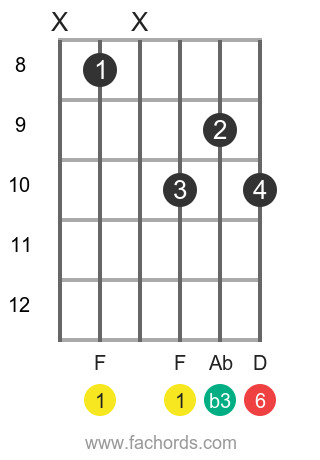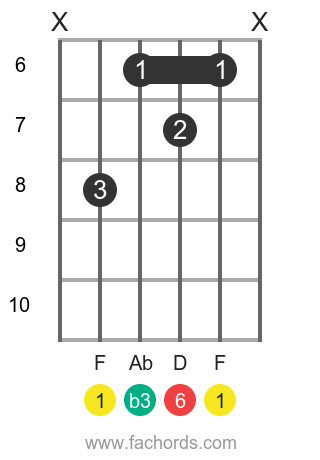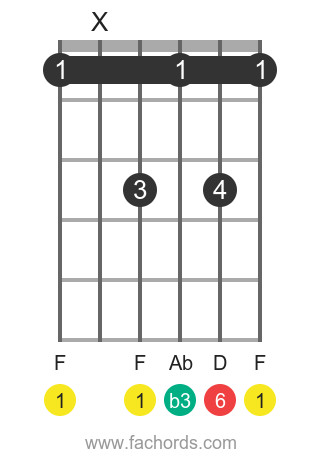The Fm6 Guitar Chord, often written as F minor 6, is a captivating chord that adds a touch of sophistication and depth to your guitar playing. Belonging to the family of minor chords, the Fm6 brings a unique flavor that you’ll find in genres ranging from jazz to pop. This chord is built from four notes: F, Ab, C, and D, creating a rich, melancholic sound that is both intriguing and beautiful.
To truly understand the Fm6 chord, it’s helpful to break down its construction. Like all chords, the Fm6 is formed using intervals. In this case, we combine the Root (1), a Minor Third (b3), a Perfect Fifth (5), and a Major Sixth (6). This combination of intervals—Root, minor third, perfect fifth, and major sixth—is what gives the Fm6 its distinctive character. If you’re new to the concept of intervals and how they build chords, exploring resources like our fretboard intervals tutorial and guitar music theory tutorial can significantly enhance your understanding.
Understanding the Fm6 Chord Construction
Let’s delve a bit deeper into the theory behind the Fm6 chord. The formula for a minor sixth chord is rooted in understanding musical intervals. Here’s a breakdown of how the Fm6 is constructed:
- Root (1): This is our foundation note, F.
- Minor Third (b3): Moving up a minor third from F, we get Ab.
- Perfect Fifth (5): A perfect fifth above F is C.
- Major Sixth (6): Finally, a major sixth above F gives us D.
These four notes – F, Ab, C, and D – are the building blocks of the Fm6 chord. This combination creates a minor tonality enriched by the major sixth, giving it a more complex and emotionally resonant sound compared to a standard F minor chord. Understanding chord construction through intervals is a fundamental aspect of guitar theory and will empower you to learn and create a wide range of chords.
Playing the Fm6 Guitar Chord in Different Positions
Now, let’s get practical and look at how to play the Fm6 chord on your guitar. Chord diagrams are essential tools for visualizing finger placements on the fretboard. Here are a few common positions for playing the Fm6 chord, each offering a slightly different voicing and feel.
Position 1: Movable Shape
 Fm6 chord diagram position 3 for guitar
Fm6 chord diagram position 3 for guitar
This first position is a movable shape, meaning you can slide it up and down the neck to play different minor 6th chords. It’s a versatile voicing that’s relatively easy to grasp and apply in various musical contexts. Experiment with moving this shape to understand how it can be used to play other m6 chords.
Position 2: Barre Chord Shape
 Barre chord diagram for Fm6 position 2 on guitar
Barre chord diagram for Fm6 position 2 on guitar
The second position utilizes a barre chord shape, which might be slightly more challenging for beginners but offers a full and powerful sound. Barre chords are fundamental techniques for guitarists, allowing you to play chords across the neck. If you’re working on barre chords, our Bar Chords Tips tutorial can provide valuable guidance. This Fm6 barre chord shape is also movable, expanding your ability to play minor 6th chords in different keys.
Position 3: Another Movable Position
 Another movable position for Fm6 chord diagram
Another movable position for Fm6 chord diagram
This third position provides another movable voicing for the Fm6 chord. It offers a different sonic texture compared to the previous positions and can be useful in various musical situations. Like the first position, its movable nature makes it a valuable tool for playing different minor 6th chords efficiently.
For more chord shapes and voicings, be sure to explore our extensive all guitar chords online library. You can also download our Free Guitar Chords Chart Pdf for a handy printable reference. Additionally, for a text-based representation of chord diagrams, you can visit our accessible chords page.
Exploring Other Minor 6th Chords
Once you’re comfortable with the Fm6, you can expand your chord vocabulary by learning other minor 6th chords. Here are a few to get you started:
C m6 | D m6 | E m6 | G m6 | A m6 | B m6 | C#m6 | D#m6 | F#m6 | G#m6 | A#m6 | Abm6 | Bbm6 | Dbm6 | Ebm6 | Gbm6
Experimenting with different root notes for the m6 chord will broaden your musical palette and deepen your understanding of chord relationships on the guitar fretboard.
Conclusion
The Fm6 guitar chord is a valuable addition to any guitarist’s toolkit. Its unique sound, derived from its minor and major sixth intervals, opens up exciting possibilities in your playing. By understanding its construction, practicing different positions, and exploring related chords, you’ll be able to incorporate the Fm6 chord effectively into your music. Remember, consistent practice and a curious approach to learning are key to mastering new chords. Dive into the world of sixth guitar chords tutorial to further enhance your knowledge and versatility. Happy playing!
